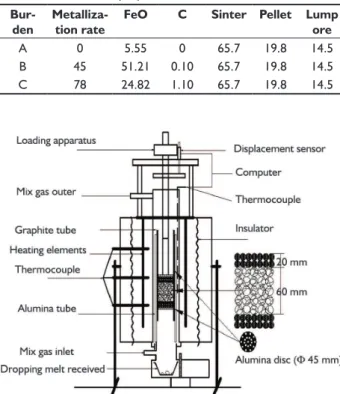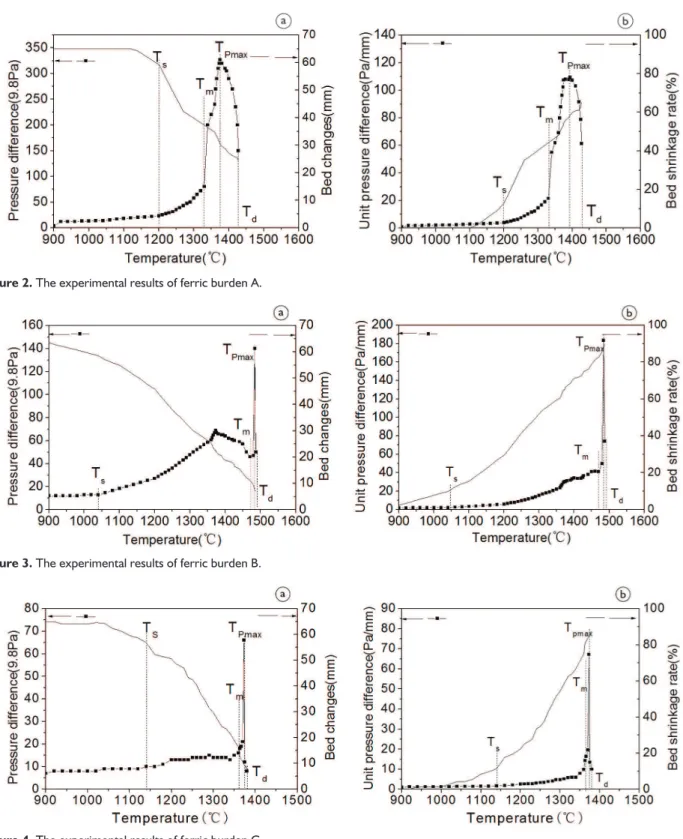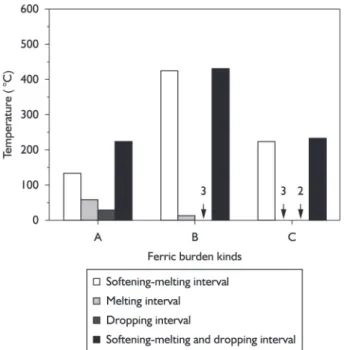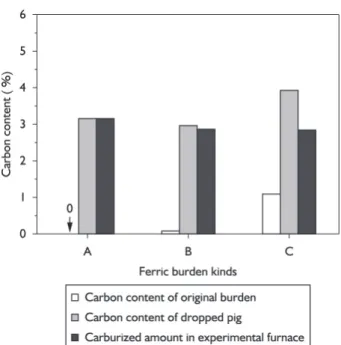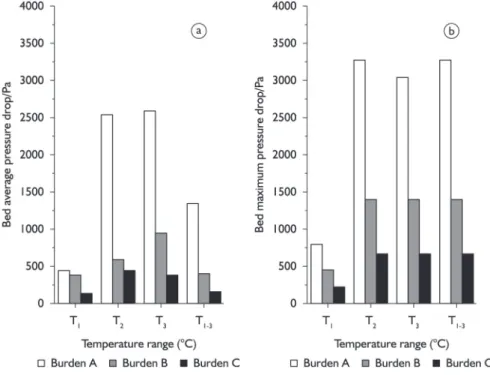http://dx.doi.org/10.4322/tmm.2014.051
Original Article
Abstract
The inferences of burden metallization rate on softening-melting dropping properties were investigated through melting dropping test of three kinds of metalized burden pressure drop. The results indicated that the softening-melting temperature interval of pre-reduction mixed burden is bigger than primeval mixed burden, the softening-melting interval narrow with the rise of metallization rate of ferric burden as well as dropping temperature interval. The average pressure drop, maximum pressure drop and softening-melting dropping properties eigenvalue decrease with the rise of metallization rate of ferric burden. Besides, the dropping temperature of burden reduces with the rise of carbon content of molten iron. The combination high metalized burden and higher carbon content of molten iron is benefit to decreasing thickness of cohesive zone and improve permeability of cohesive zone.
Keywords: Iron-bearing burden; Metallization rate; Softening-melting dropping properties; Blast furnace.
1 INTRODUCTION
In order to meet the need of the global “low carbon economy”, energy savings and pollutant reductions on blast furnace ironmaking process is becoming a strategic problem to be solved in iron and steel industry. Softening-melting dropping property (SDP) of iron-bearing burden has great effect on blast furnace operation [1] such as smooth operation, productivity, fuel consumption and molten iron components and so on.
Excellent softening melting dropping property of iron-bearing burden inside blast furnace is an important index in ironmaking research. Although lots of works such as the influences of iron-bearing burden proportion, Fe content, MgO content and binary basicity on SDP have been studied before [2-6], few work focused on the effect of metallization rate on SDP.
Besides, it is possible to use some metalized burden in blast furnace with implement of sponge iron production process with rotary hearth furnace [7-9]. Study shows that the innovation process based on ore-coke coupling reaction is expected to increase metallization degree of burden [10,11]. The influence of these metalized burdens on SDP is becoming the hot spot in ironmaking research.
In order to investigate and master the varied law of SDP, experiments are conducted about different degrees of metalized burden. Relationships between SDP and correla-tive factors i.e. metallization rate and carbon concentration of the iron-bearing burden, carburizing rate, carbon content in hot metal are deeply studied in this paper.
2 MATERIAL AND METHODS
Experiments have been conducted on the softening--melting dropping properties of unreduced ferric burden A and pre-reduced burden B, C, and the Ts, Tm, Td, shrinkage characteristic, pressure drop and SMD difference of them are compared.
The composition of ferric burden is listed in Table 1. Ferric burden B and C are pre-reduced burden which are made from ferric burden A of 200 g reduced to metallization rate of 45% and 75% respectively. The grain size of ferric burden is 10~12.5mm, the grain size of the experiment coke from Baosteel is 6.3~10 mm.
A measuring device for high temperature proper-ties was shown in Figure 1. The burden was charged into the graphite reaction tube (inner diameter 48 mm, length 270 mm). A sample having a layer thickness of 65 mm was charged in a crucible and a layer thickness of 20 mm was placed over and below that.
Experimental conditions are shown in Table 2. Heating up rate is 10°C/min below 900°C and 5°C/min from 900°C to end, and then each experiment is finished. Gas flow is 5 L/min of N2 below 900°C and the flow rate of reducing gas is 12L/min from 900°C to end. And composi-tion of the reducing gas is CO:N2 = 70:30 (%). The burden load was 1 kg/cm2, Behavior of softening and shrinking was evaluated through measuring variations in layer thickness
1State Key Laboratory of Advanced Metallurgy, University of Science and Technology Beijing, Beijing 100083, China. E-mails: yntby@163.com;
wu_shengli@263.net; zhanglh@metall.ustb.edu.cn; jianlong231@163.com; mec.bytuo.gzu.edu.cn
2College of Mining, Guizhou University, Guiyang 550025, China
STUDY ON SOFTENING AND DROPPING PROPERTIES OF
METALIZED BURDEN INSIDE BLAST FURNACE
Bi-yang Tuo 1,2
Sheng-li Wu 1
Li-hua Zhang 1
Jian-long Wu 1
and pressure drop. The temperature and layer thickness was measured by thermocouple and displacement sensor respectively. The pressure drop between gas inlet and gas outer was measured by U tube manometer. Carbon content of molten iron (CPig) was analysed by chemical analysis. Experiment was finished once the molten iron dropped. The experiment data such as temperature, column thickness and pressure are all real time recorded in the computer.
3 RESULTS
The process parameters of ferric burden under softening-melting dropping are shown in Table 3. Results of the softening-melting dropping experiments of ferric burden A, B and C are shown in Figures 2-4 and Tables 4. The softening-melting dropping zone can be divided into three zones, namely softening-melting zone, melting zone and dropping zone in order to study the influence of ferric burden metallization rate on the softening-melting dropping
properties. Based on the above research, the ferric burden softening-melting property eigenvalue (SMD1), the melting property eigenvalue (SMD2), the dropping property eigen-value (SMD3) and the softening-melting dropping properties eigenvalue, are further studied.
4 DISCUSSION
4.1 Variation of Charge Column Height
4.1.1 Softening-melting temperature interval
Experiment results are shown in Figures 2-5. The order of Ts is: A>C>B. As for Tm, the order is: B>C>A. And the order of T1 is: B>C>A.
The reduction process of ferric burden A is Fe2O3→Fe3O4→FeO→Fe, and that of burden B and C is FeO→Fe. Reductions of Fe2O3→Fe3O4 and Fe3O4→FeO need some time to finish, which results that the charge column of burden A needs a longer time to reach Ts and Ts of burden A has exceeded that of ferric burden B and C. FeO contents in ferric burden B and C are respectively 51.21% and 24.82% at the beginning of reduction of 900°C, which begin to decrease as the reduction goes on. Therefore Ts of ferric burden B is lower than that of burden C.
The main reason why Tm of burden A is higher than that of burden B, is that the metallization rate of burden B is 45% at the beginning of reduction and the metallization rate becomes higher with the reduction, and the whole ferric burden B is almost reduced to spongy iron which is difficult to produce low melting point mineral. The main reason Tm of burden B is higher than that of burden C is
Table 1. Ferric burden properties /%
Bur-den
Metalliza-tion rate
FeO C Sinter Pellet Lump
ore
A 0 5.55 0 65.7 19.8 14.5
B 45 51.21 0.10 65.7 19.8 14.5 C 78 24.82 1.10 65.7 19.8 14.5
Figure 1. Schematic diagram of softening-melting dropping experi-mental apparatus and charging.
Table 2. Melting and dropping experiment condition of ferric burden
Ferric burden
before 900°C after 900°C
N2 Gas
flow
Hearting rate
N2 CO Gas
flow
Heating rate
% L/min °C/min % % L/min °C/min
A
100 5 10 70 30 12 5
B C
Table 3. Process parameters of ferric burden under softening-melt-ing droppsoftening-melt-ing
Symbol Meaning Unit
Ts Temperature when bed shrinkage rate increase obviously or unit bed pressure drop markedly elevated and this temperature where the charge column height shrinkage is about 10%
°C
Tm Temperature at which the pressure drop or unit pressure drop start steeply rise at the moment
°C
TPmax Temperature of unit bed maximal pressure drop °C Td Temperature when molten iron begin to drop °C T1 Softening-melting temperature interval (T1= Tm- Ts) °C T2 Melting temperature interval (T2= TPmax- Tm) °C T3 Dropping temperature interval (T3= Td- TPmax) °C T1~3 Softening-melting dropping temperature interval
(T1~3= Td- Ts)
°C
S1 Shrinkage value of burden column height in soft-ening-melting temperature interval
%
S2 Shrinkage value of burden column height in melt-ing temperature interval
%
S3 Shrinkage value of burden column height in drop-ping temperature interval
%
that all of ferric burden B and C are almost reduced to iron and the liquid appearance temperature of charge burden decreases as carbon content of burden increases according to blue lines in the Fe-C diagram in Figure 6. Therefore, the carbon content of ferric burden C is higher than that of burden B.
Table 4 shows that in the softening melting tempe-rature range, the shrinkage value (S1) of charge column B
is the minimum and that of burden A is the next and that of burden C is the maximum. The main reason is analyzed as following. Compared with ferric burden B, Ts of burden A is higher, and T1 is narrower, the liquid formation rate is relatively fast, thus the shrinkage rate is smaller.
While T1 of burden B is wider, and the softening--melting shrinkage is slower, and S1 corresponding to Tm is relatively large, therefore softening-melting process is more
Figure 2. The experimental results of ferric burden A.
Figure 3. The experimental results of ferric burden B.
Table 4. Temperature interval parameters and shrinkage range of burden
Burden CPig Ts Tm TPmax Td T1 T2 T3 T1~3 S1 S2 S3
% °C %
A 3.16 1200 1335 1394 1425 135 59 31 225 31 15 6
B 2.95 1045 1470 1484 1487 425 14 3 442 28 5 2
C 3.93 1146 1370 1373 1375 224 3 2 229 36 2 1
Figure 5. Effect of different metallic ferric burden on its softening-melting dropping interval.
Figure 6. Fe-C diagram.
completed. Compared with ferric burden B, Tm of ferric burden C is rather low, but S1 is relatively large.
4.1.2 Melting temperature interval
Melting temperature interval (T2) of ferric burden is defined as difference values between melting starting temperature (Tm) of charging column and melting ending temperature (TPmax). The value reflects the high tempera-ture melting properties of ferric burden to some extent. T2 of ferric burden A is the maximum, and burden B is the next, and burden C is the minimum, which is presented in Table 4 and Table 5. Obviously, burden metallization rate is larger, the narrower T2.
by means of Figure 7. Therefore, TPmax of ferric burden is mainly determined by metallization rate of charging burden and carbon content, and the higher carbon content is at the same metallization rate condition, the lower TPmax becomes.
As can be seen from Table 4, the charge column shrinkage value (S2) of ferric burden A, B and C in melting temperature range are 15%, 5% and 2% respectively. The T2 of burden B and C is rather narrow in comparison with burden A. The reason is that the liquid content of burden B and C increase rapidly to the maximum, and the sharp increasing interval of liquid content is rather narrow. T2 of ferric burden C is narrower than burden B, which because that the metallization rate of burden C is larger than that of burden B. Therefore, in melting temperature interval, the S2 decreased with the rise of metallization rate, and the higher the burden metallization rate is, and the lower the increased value of shrinkage rate is.
4.1.3 Dropping temperature interval
The dropping temperatures (Td) of ferric burden A, B and C are 1,425°C, 1,487°C and 1,375°C respectively, and the dropping temperature ranges are 31°C, 3°C and 2°C, which is illustrated in Table 4 and Table 5. Td of ferric burden mainly depends on the carbon content in molten iron and Figure 6 and Figure 7 indicate that Td of molten iron is related with the carbon content (CPig) in molten iron, which shows that the higher CPig is, the lower Td becomes. T3 of burden A, B and C reduces in turn, which is mainly because of the rise of burden metallization rate leading to the narrowing of dropping temperature interval. The high metallization rate of ferric burden C causes T3 only 2-3°C, which pressure drop reduce immediately after burden melted. So Td of burden decreases with the increase of CPig, and T3 narrows with the rise of the metallization rate. As can be seen from Figure 7, the carburized amount of burden in experimental furnace is less related to metallization rate and carbon content of raw material, and CPig is directly correlated to the carbon content of the ferric burden before charging into experimental furnace.
In dropping temperature interval, the charge column shrinkage value (S3) of ferric burden A, B and C are 6%, 2% and 1% respectively, which is listed in Table 4. The higher the metallization rate is, the smaller the corresponding S3 value in dropping temperature range is. The main reason is that all of ferric burden has melted into liquid in dropping temperature interval, and the thickness of charging column
is minimum, which leads to charging column not shrink again in theory, while there is a little change actually, and this is mainly attribute to the decrease of surface viscosity of liquid making the surface liquid drop into coke layer. The molten slag and iron viscosity of burden A is rather high and the no-dropping temperature interval is much wider than burden B. While the molten slag and iron viscosity of burden B and C is rather low, the no-dropping temperature interval of which is much narrow and the interval value is only 2-3°C. And the slag and molten iron residence time in dropping temperature interval becomes short with the rise of the metallization rate. Therefore, the high metallization rate burden is beneficial to decrease the molten slag and iron viscosity and the width of dropping temperature interval.
In conclusion, the T1 and T1~3 of burden A are narrower than that of burden B and C. And T2 and T3 of burden A, B and C becomes narrow with the increase of metallization rate. The charging column shrinkage value of burden B and C is much larger than burden A. Conside-ring T1 alone, it seems that the softening-melting dropping properties of unreduced ferric burden is better than metalized burden. However whether wider T1 indicate bad soften-melting dropping properties needs to be studied further. The discussion of the influence of metallization
Table 5. Pressure drop and property eigenvalues of ferric burden
Burden Pav1 Pav2 Pav3 Pav SMD1 SMD2 SMD3 SMD
Pa kPa·°C
A 440 2530 2590 1342 57 162 85 304
B 390 599 950 393 167 8 3 178
C 141 435 390 148 24 1.3 0.8 26.1
rate of ferric burden on charging column pressure drop is shown as following.
4.2 Pressure Drop Changes of Charge Column
Pressure drop of the cohesive zone is the maximum in blast furnace. It is about 60% of the total pressure drop, and it determines the stable of blast furnace smelting operation [12]. It is important to study the influence of metallization rate of ferric burden on the pressure diffe-rential in softening-melting dropping process.
As can be seen from Figures 2, 3 and 4, with rising charging column temperature, the charging column pressure drop of burden A increases rapidly to maximum and then decreases slowly and at this moment the molten iron starts dropping. Charging column pressure drop of burden B firstly increases slowly to a higher point, then increases sharply to the maximum, at this moment the molten iron starts drop-ping. While pressure drop of burden C increases steeply and then decreases immediately before the molten iron drops. In the softening -melting interval, the unit pressure drop of burden A, B and C increase slowly, and when the charging column temperature reaches to melting starting tempera-ture, the unit pressure drop sharply increases to maximum for the decrease of lacuna in charging column caused by the rapidly melting of burden, which is listed in Figures 3, 5 and 7. Melting terminates at the moment, but the molten iron will not drop immediately for higher viscosity.
Seen from charging column permeability in softe-ning-melting temperature interval, the unit charging column pressure drop of burden A, B and C increase slowly. As can be seen from Table 5 and Figure 8, both the average pressure drop (Pav1) and maximum pressure drop decrease
with increasing metallization rate, thus the charging column permeability of burden A is the worst, that of burden B is better, and that of burden C is the best. Therefore, the char-ging column permeability is improved with the rise of the metallization rate in softening melting temperature interval.
As for the charging column permeability in melting temperature interval, the unit charging column pressure drop of burden A, B and C all increase rapidly to maximum, which are listed in Table 5. As can be seen from Figure 8, both the average pressure drop (Pav2) and maximum pres-sure drop decrease with the rise of metallization rate in melting temperature interval, it again shows that the higher the metallization rate is, the better the charging column permeability is.
The variation of charging column permeability in the dropping temperature interval is presented in Figures 2, 3 and 4. In general, the charging column pressure drop reduces gradually or sharply in dropping temperature interval. As is shown in Table 5, the maximum pressure drop and average pressure drop (Pav3) of ferric burden decrease with the rise of metallization rate in dropping temperature interval.
Above analysis illustrates that the charging column pressure drop is mainly related to the liquid phase volume of slag and iron and the melting condition of iron metal. The reduction process of burden A is much long, and the FeO content increases to the maximum and then decreases slowly with the rise of temperature. So the higher pressure drop range of burden A is rather large.
While the average pressure drop (Pav) and maximum pressure drop (Pmax) of burden B and C are small in softe-ning-melting dropping interval, and maximum pressure drop
interval is narrow, it indicates that the iron in charge column of pre-reduced burden melts rapidly at a certain tempera-ture, then penetrates into the coke passages, and drop in a flash. This causes the peak value interval of maximum pres-sure is only 2-3°C. So the higher the metallization of ferric burden is, the better the permeability of charge column is.
4.3 Softening-melting Dropping Property Eigenvalue of Ferric Burden
The charge column lacuna of ferric burden gradually decreases to disappear from softening-melting starting temperature to dropping temperature. The charging column shrinkage in softening-melting, melting and drop-ping temperature interval all affect the burden smelting. Evaluating exactly softening-melting, melting, and dropping properties makes an important significance on blast furnace ironmaking.
The softening-melting dropping property eigenvalue is defined as the sum of the temperature integral of pressure drop function in softening-melting, melting and dropping temperature interval. In order to calculate conveniently, the calculation with infinitesimal method for pressure drop function needs to be fitted with the experiment data [13]. Each interval SMD is calculated by formula 1.
( ) ( ) ( ) ( ) + + = = = + + = + + = + × −
∫
∫
∑
∫
∫
d m s s Pmax d m Pmax T T1 2 3
T T
n
T T
i 1 i i 1 i
T T
i 1
SMD P T dT SMD SMD SMD P T dT 1
P T dT P T dT (P P ) (T T ) 2
(1)
This formula indicates that SMD is the integral of pressure drop to temperature from Ts to Td range. Each temperature interval indicates the width of T1, T2 and T3. The integral of pressure drop to temperature of each temperature interval is defined as softening-melting property eigenvalue (SMD1), the melting property eigen-value (SMD2) and dropping property eigenvalue (SMD3), which are shown in Table 5. Ti is arbitrary temperature value from Ts to Td. Pi is the corresponding pressure drop value of temperature Ti. The formula is helpful to further understanding about the width of T1, T2 and T3 of each ferric burden, and the pressure drop variance of charging column and the property eigenvalue are also characterized by it. To use the formula 1 is beneficial to correctly evaluate the SMD of ferric burden. By formula 1 known, in the same temperature interval, the smaller the eigenvalue of SMD is, the better the permeability of cohesive zone becomes in blast furnace.
The SMD calculated by formula 1 is shown in Table 5 and Figure 9. The SMD1 of burden B is the maximum, SMD1 of burden A is the next and SMD1 of burden C is the minimum.
The Fe2O3 in burden A is gradually reduced to FeO, and part of FeO is also reduced to Fe with rising temperature. FeO would not affect the charging column permeability until FeO content is accumulated to a certain
level in a higher temperature. Compared with burden A, the FeO content of burden B is the maximum and the value is 51.21% when burden B begin to be reduced at 900°C, which produces much of low melting temperature subs-tance. Lacuna of charging column reduces, and pressure drop rises, and the permeability becomes worse for the softening-melting of low melting temperature substance. In addition, Ts of burden B becomes lower, and T1 becomes wider because of the maximum FeO content at the begin-ning of reduction. Therefore, SMD1 of burden A is larger than that of burden B in softening-melting temperature interval. While the FeO content in burden C is much smaller at the beginning of reduction, FeO gradually reduces to Fe with rising temperature. This leads to lower amounts of the low melting temperature substance produced by FeO and oxides in gangue minerals, which has little influence on the permeability of charging column, so the charging column pressure drop of burden C is rather low and the permeability is the best.
As can be seen from Table 5 and Figure 9, the SMD2 of ferric burden A is the maximum, followed by that of burden B and that of burden C is minimum. The maximum SMD2 of burden A is caused by wider T2 and higher pres-sure drop of the charging column, which can be verified in Figure 2 and Figure 3. While the maximum liquid volume of burden A in melting temperature interval causes the pres-sure drop of charging column larger. The SMD2 of burden B and C is 8k Pa·°C and 1.3k Pa·°C respectively. This indicates that burden B and C are almost turned into Fe, which makes the temperature interval rather narrow and pressure drop much low. In conclusion, SMD2 of ferric burden decreases with increasing metallization rate.
SMD3 of ferric burden A is the maximum, burden B is the next and burden C is the minimum, according to Table 5 and Figure 9 The main reason is that the viscosity of melting slag and iron of burden A is much high in the dropping
• When the metallization rate of ferric burden
is improved, the pressure drop steep rising temperature pressure dropincreases, the melting temperature interval becomes narrow, and the pressure drop of charge column decrease, the permeability is improved.
• Compared with unreduced burden A, the carbu
-rization reaction of metalized burden becomes weak, and the dropping temperature increases with the decreases of carbon content of meta-lized burden. The carbon content of molten iron increases with rising carbon content of metalized burden that resulting in decreasing dropping temperature of burden.
• The combination of high metalized burden
and higher carbon content of molten iron can decrease the liquid volume of charging column in high temperature, improve the softening-melting dropping properties of ferric burden and decrease the pressure drop of cohesive zone, and improve the permeability.
Acknowledgements
The financial support of the National Natural Science Foundation of China (50974143), and Fundamental Research Funds for the Central Universities (FRF-TP-12-021A) is grate-fully acknowledged.
temperature interval, the no-dropping temperature interval of melting slag and iron is much wider, that is the duration of the higher pressure drop is rather long. While SMD3 of burden B and C is much small, because that the much low viscosity of melting slag and iron of high metallization rate cause it to drop immediately after melted and layered, which results in the narrow dropping temperature interval.
The softening-melting dropping interval, T1~3, of burden A, B and C is 225°C, 432°C and 229°C, while the average pressure drop(Pav) of burden is 1,342Pa, 393Pa and 148Pa respectively. SMD of ferric burden decreases with the rise of the metallization rate. In conclusion, the softening--melting dropping properties of ferric burden cannot be evaluated only by softening melting dropping temperature range, because the pressure drop is more important than the temperature range. Therefore the softening-melting dropping properties ought to be evaluated by real time differential pressure combined with temperature range.
5 CONCLUSIONS
• With the rise of metallization rate of ferric burden,
the softening-melting starting temperature decre-ases, the softening-melting temperature interval becomes wide, but the total pressure drop of softening-melting layer obviously decreases and permeability is improved.
REFERENCES
1 Yutaka U, Kaoru N, Yoshinor M, Kohei S, Shusaku K, Takaiku Y. Subjects for achievement of Blast Furnace operation with low reducing agent rate. ISIJ International. 2005;45(10):1379-1385. http://dx.doi.org/10.2355/ isijinternational.45.1379.
2 Chin EL, Leanne TM, Damiea PO. Lump ore and sinter behaviour during softening and melting. ISIJ International. 2011;51(6):930-938. http://dx.doi.org/10.2355/isijinternational.51.930.
3 Wu SL, Han HL, Xu HF, Wang H, Liu X. Increasing lump ores proportion in Blast Furnace based on the high-temperature Interactivity of Iron bearing materials. ISIJ International. 2010;50(5):686-694. http://dx.doi.org/10.2355/ isijinternational.50.686.
4 Kohei S, Kaoru N, Masahiko H, Takanobu I, Shusaku K, Takaiku Y. Effect of high Al2O3 slag on the Blast Furnace operations. ISIJ International. 2008;48(4):420-429. http://dx.doi.org/10.2355/isijinternational.48.420.
5 Hideki ON, Chikahito S, Tateo U. Effect of slag components on reducibility and melt formation of iron ore sinter. ISIJ International. 2002;42(5):558-560. http://dx.doi.org/10.2355/isijinternational.42.558.
6 Sun H, Kunihiko N, Katsumi M. Influence of Slag Composition on Slag–Iron Interfacial Tension. ISIJ International. 2006;46(3):407-412. http://dx.doi.org/10.2355/isijinternational.46.407.
7 Hiroyuki M, Hironori S, Shoji H. Influence of mixing coal composite iron ore hot briquettes on Blast Furnace simulated reaction behavior in a packed mixed bed. ISIJ International. 2011;51(8):1247-1254. http://dx.doi. org/10.2355/isijinternational.51.1247.
8 Yuki T, Tomohiro U, Keiji O, Shoji H. Reaction behavior of coal rich composite Iron ore hot briquettes under load at high temperatures until 1400°C. ISIJ International. 2011;51(8):1240-1246. http://dx.doi.org/10.2355/ isijinternational.51.1240.
10 Shiro W, Kanji T, Hirobumi N, Shigeaki G, Nozomu N, Tetsuro U et al. Development of high ratio coke mixed charging technique to the Blast Furnace. ISIJ International. 2006;46(4):513-522. http://dx.doi.org/10.2355/ isijinternational.46.513.
11 Kaushik P, Fruehan RJ. Mixed burden softening and melting phenomena in blast furnace operation Part 3 –
Mechanism of burden interaction and melt exudation phenomenon. Ironmaking & Steelmaking. 2007;34(1):10-22. http://dx.doi.org/10.1179/174328106X118161.
12 Wang XL. Iron and steel metallurgy. Beijing: Metallurgical Industry Press; 2008.
13 Wu SL, Tuo BY, Zhang LH, Guo L, Wu JL, Zhou Y. Study on influence law of coke reactivity on softening dropping property of ferric burden in blast furnace. Journal of University of Science and Technology Beijing. 2012;30(4):10-22.
